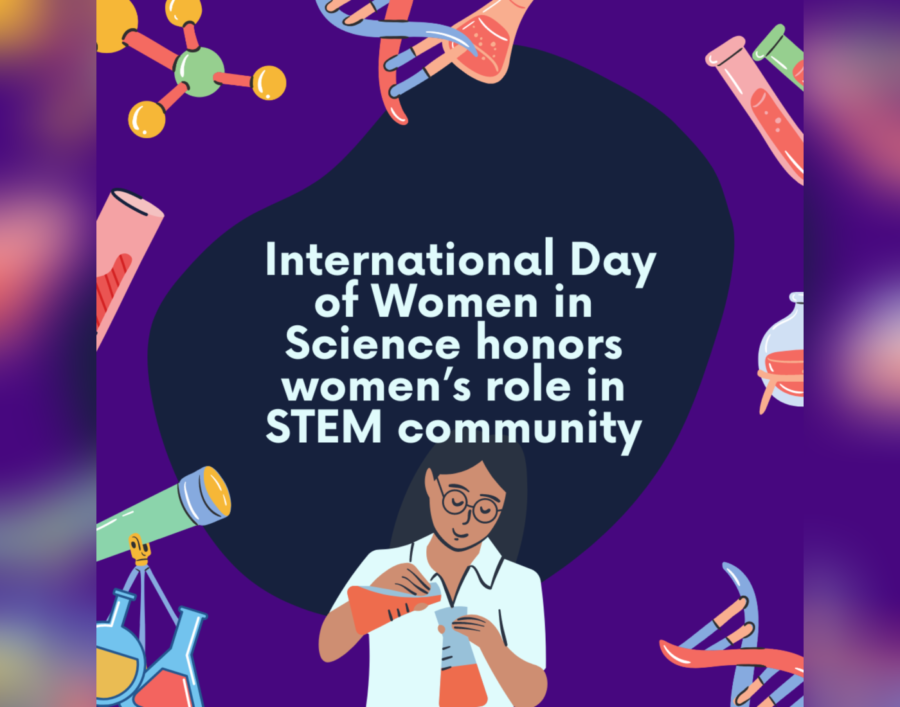International Day of Women in Science honors women’s role in STEM community
February 9, 2022
International Day of Women and Girls in Science is an important holiday that recognizes the critical role women play in the STEM community. Although the day is not widely covered in the media, International Day of Women and Girls in Science has helped inspire women and girls around the world to not let prejudices hold them back from accomplishing things they have always been capable of.
The holiday is inspired by the United Nations’ (UN) goal to end gender inequality in all forms, specifically in the STEM community to help with the future success of the 2030 Agenda for Sustainable Development. In December 2013, the UN came to the realization that women becoming more involved in the STEM community without facing prejudices would be an enormous contribution to the progress of meeting the agenda. Considering women make up half the world’s population, with their help they would be able to accomplish more at a faster rate. It was not until Dec. 22, 2015 that the UN decided to mark Feb. 11 as the International Day of Women and Girls in Science during the United Nations General Assembly.
In recent years women have increased the amount of female participation in STEM, but due to repercussions of the gender gap, women are still very under-represented in the field. Women currently only make up 28% of the STEM workforce, which is a significant increase from 8% in 1970. Science teacher Ms. Sara Baranczyk was quickly able to notice how undiverse her college environment was while taking STEM classes. Baranczyk said, “My freshman year of college, I was in one of my general physics classes and I was the only girl in a class of about 45 people. So it was very obvious that I was in a male dominated field.” Even with the increased involvement in the STEM community, women are least likely to go into engineering and computer or mathematical sciences. In OHS specifically, only a third of the teachers in the science and mathematical department are women.
Not only is there little representation of women in the professional aspect of the STEM field, but also in school-led clubs. Many high schools in the nation have robotics or other specific science clubs where students who show interest in the field can participate whilst gaining new experience and knowledge. Often the male to female ratio is very disproportionate and it clearly shows during practice and competitions. Junior Kinzie Carlson, the business lead of the OHS Robotics team, has shared many of the struggles other women in the field have faced. Carlson said, “As a woman, it can be difficult to get my voice in the conversation sometimes. It can be a struggle to get respect from some of my peers; it gets really frustrating. I am the business lead, so I don’t do much hands-on work when it comes to the robot stuff, but I still have valuable ideas to add to the team, and I hope we can progress more so my fellow female peers and I can be more accepted in the future.” Currently out of the 27 members of the robotics team only six are female, in the past and still to an extent today, the robotics competition nationwide has been male-dominated. In recent years though, there has been more advocacy for equal involvement in the nationwide competition.
Due to the small number of women in STEM and recognition of accomplishments of said women, younger girls are less likely to pursue a career in the field due to a lack of role models. Not only are girls unable to visualize themselves in STEM due to little representation, STEM is often made out to be a masculine career path that often gives off an unwelcoming environment towards women. Ms. Baranczyk said, “If you really like the subject and even if it’s a frustrating subject, and it’s really challenging, make sure that you still love the subject and that you’re not basing your opinion of it on the environment you’re in.” Perseverance is the key to breaking through the male dominated field.
Although women face lots of challenges entering a male dominated field where they are severely underrepresented, it doesn’t mean that they are any less capable of performing just as well as men. Many huge discoveries and milestones in science were founded and researched by women. Stem cell isolation, a major breakthrough that helped advance and develop new medical procedures like bone marrow transplants, was discovered by Dr. Ann Tsukamoto and her colleagues. Sadly, not all female scientists are able to get the recognition they deserve. Rosalind Franklin, for instance, is the rightful discoverer of the double helix structure of DNA, a discovery often attributed to the infamous pair Watson and Crick. Whether their discoveries were stolen from them or not, the point of the matter is that women are capable of extraordinary things.
International Day of Women and Girls in Science highlights the struggles women and girls face in a field they belong in just as much as males. This year will mark the seventh assembly of International Day of Women and Girls in Science, and the theme is “Equity, Diversity and Inclusion: Water Unites Us”, which will bring together female scientists and legislators from all around the world to discuss the importance of water as a vital worldwide resource.







